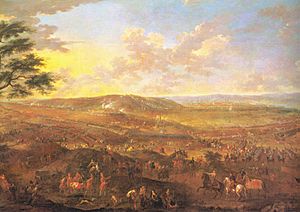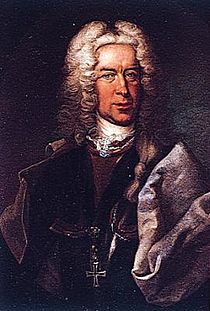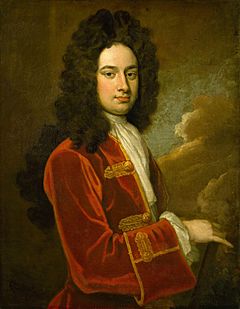Battle of Saragossa facts for kids
Quick facts for kids Battle of Saragossa |
|||||||
|---|---|---|---|---|---|---|---|
| Part of the War of the Spanish Succession | |||||||
 A painting of the battle |
|||||||
|
|||||||
| Belligerents | |||||||
| Commanders and leaders | |||||||
| Strength | |||||||
| 30,000 | 26,000 20 guns |
||||||
| Casualties and losses | |||||||
| 1,500 dead or wounded | 5,000 to 6,000 dead or wounded 7,000 captured 20 guns captured |
||||||
The Battle of Saragossa, also known as the Battle of Zaragoza, happened on August 20, 1710. It was part of the War of the Spanish Succession. In this battle, a Spanish army loyal to Philip V of Spain was defeated. This army was led by the Marquis de Bay. They lost to a group of allied forces called the Grand Alliance. This allied force was led by Guido Starhemberg.
Even though the Grand Alliance won this battle, they couldn't keep their advantage. This victory allowed Philip's rival, Archduke Charles, to enter Madrid, the capital of Spain. However, the allies had to retreat later. They then lost two more battles: Brihuega in November and Villaviciosa in December. These defeats meant that Archduke Charles would not become the King of Spain.
How the Battle Started

The fighting in Spain in 1710 began on May 15. The Spanish army, led by King Philip V himself and Francisco Castillo Fajardo, Marquis of Villadarias, moved towards the town of Balaguer. Guido Starhemberg, who was in charge of the Allied forces in Catalonia, stopped this attack. He prevented the Spanish from crossing the Segre river. British officers played a big part in this success.
In June, King Philip got more soldiers. He tried again to take Balaguer with 20,000 foot soldiers and 6,000 horse soldiers. But he was defeated at Almenar on July 27. The allied troops had taken a strong defensive spot. They pushed back the Spanish attacks. Then, the British commander, James Stanhope, led his soldiers forward. He broke through the Spanish lines. King Philip had to go back to Zaragoza, the capital of Aragon. The French general Alexandre Maître, Marquis de Bay took over from Villadarias.
On August 9, the Spanish army reached Zaragoza. De Bay placed his troops with the Ebro river on their left side. The Torrero heights were on their right. On August 15, an Allied horse soldier attack was stopped. For five days after that, there were small fights. Then, on August 19, the Allies crossed the Ebro river with many soldiers. They were allowed to get ready during the night.
The Battle of Saragossa
The two armies were about the same size. The Allies had 37 groups of foot soldiers and 43 groups of horse soldiers. The Spanish army had 38 groups of foot soldiers and 54 groups of horse soldiers. The Allied left side had soldiers from Catalonia and the Netherlands. They were led by the Count of Atalaia. The right side was led by Stanhope. It had British, Portuguese, and Austrian horse soldiers. Starhemberg was in charge of the middle. This part mainly had German, Austrian, and Spanish foot soldiers.
On August 20, at 8:00 AM, the cannons started firing. This lasted for four hours. Then, Stanhope attacked the Spanish left side. At first, the Spanish and Walloon soldiers seemed to be winning. They defeated eight groups of Portuguese horse soldiers and chased them away. This created a gap in the Spanish lines. Stanhope used this gap to scatter the disorganized Spanish soldiers. Meanwhile, in the middle and on the right, the Spanish attacks were pushed back.
The battle was similar to the one at Almenar. The Allies stopped strong attacks from the Spanish horse soldiers. Then, their foot soldiers attacked back. They pushed the Spanish army away. In less than three hours, the Allied army won a complete victory. They captured the Spanish cannons and 73 flags. Between 5,000 and 6,000 Spanish soldiers were killed or hurt. Another 7,000 were captured. The Allies lost about 1,500 men who were killed or hurt.
What Happened Next
Archduke Charles entered Zaragoza the next day. The defeat of Philip V of Spain's army was very bad. The way to Madrid was now open. Philip V left Madrid on September 9 and went to Valladolid. Archduke Charles entered Madrid on September 28. The city was very unfriendly and almost empty. Charles said, "This city is a desert!"
In the winter of 1710, Archduke Charles and the allied troops had to leave Madrid. This was because the people of Madrid were very against them. Also, their military position was dangerous. After this, the British army lost a battle at Brihuega. The rest of the allied army was defeated at the Villaviciosa.
See also
 In Spanish: Batalla de Zaragoza para niños
In Spanish: Batalla de Zaragoza para niños


